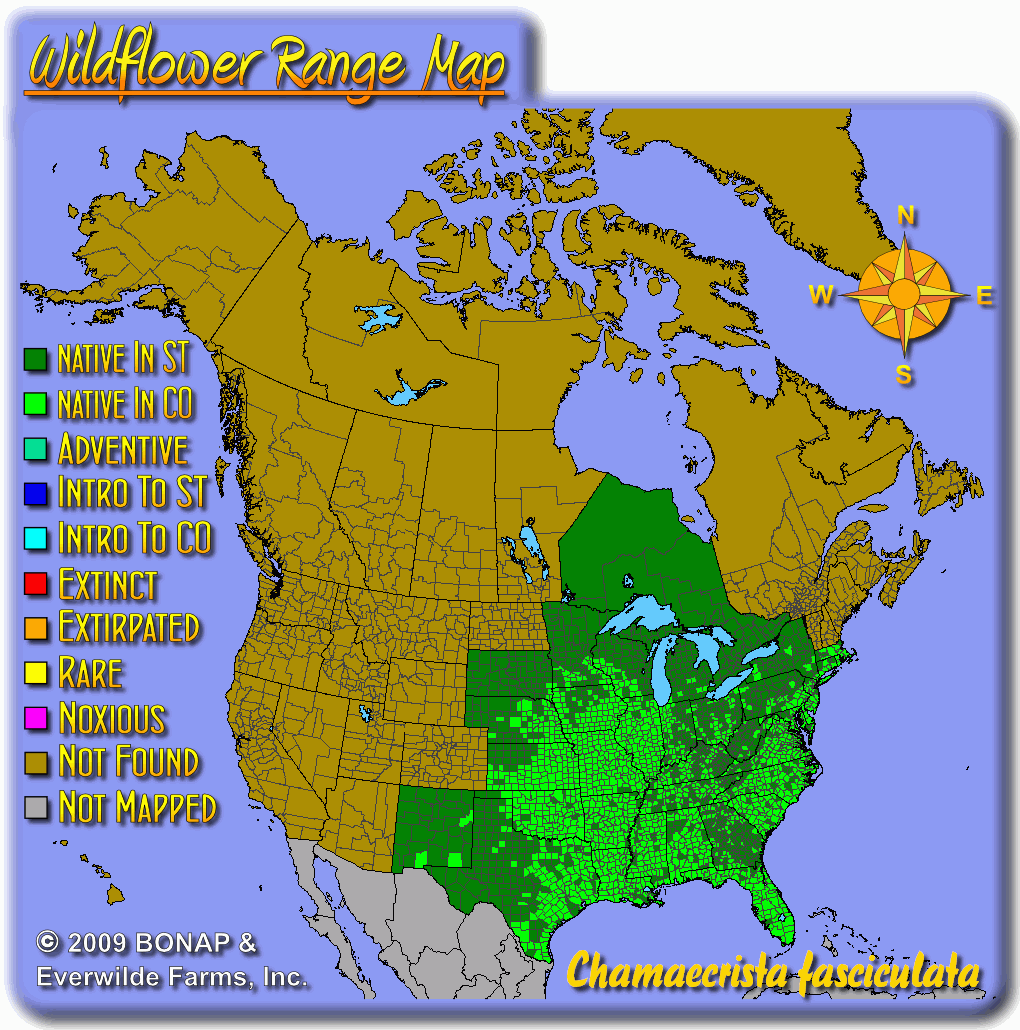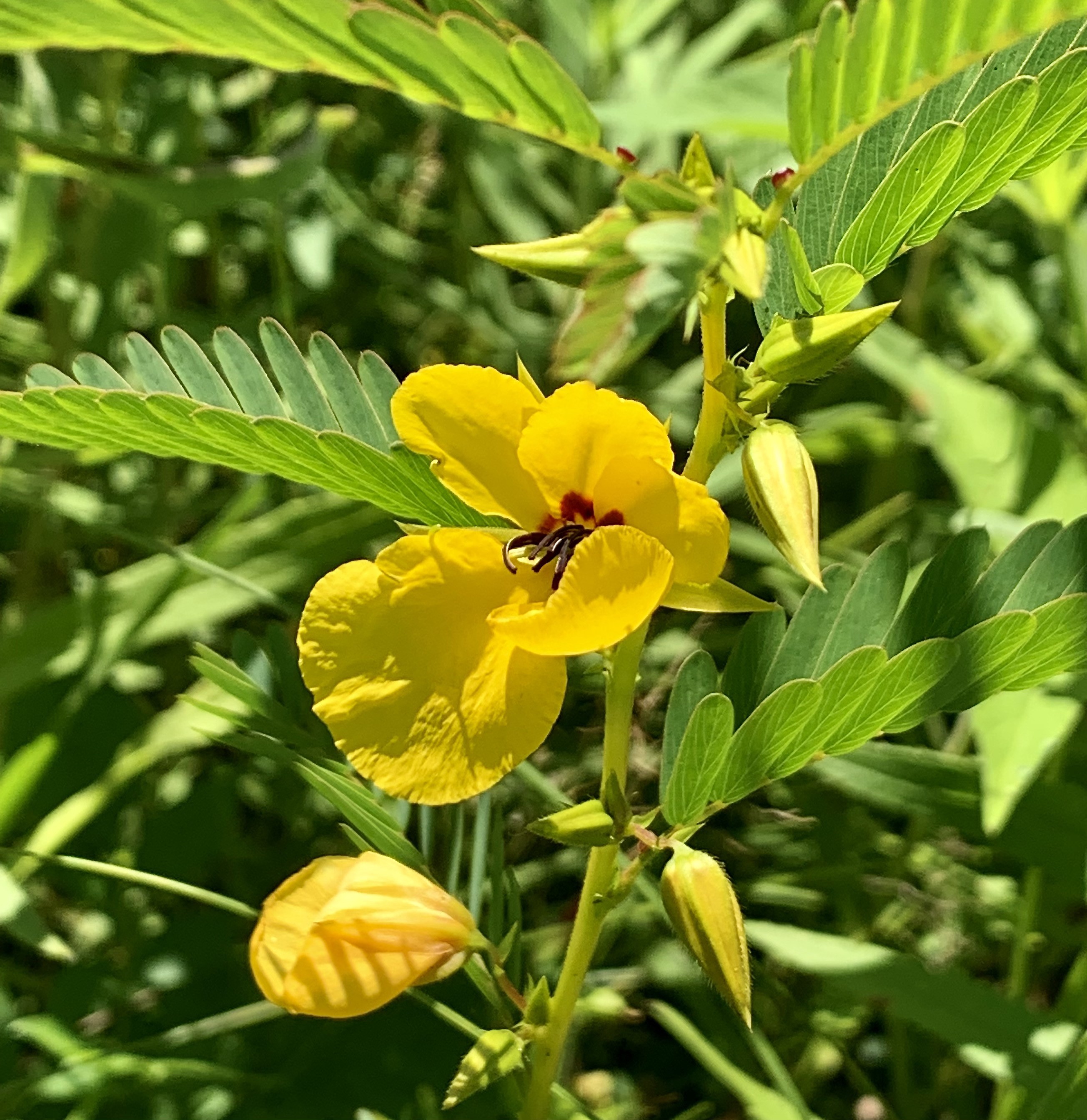Partridge Pea Seeds
- HOW TO GROW
- FAST FACTS
- REVIEWS
HOW TO GROW
Sowing: For the best germination rates, pour very hot water over the partridge pea seed and soak it overnight; next, mix it with moist sand and store it in the refrigerator for 10-20 days before planting. In early spring, plant the treated Chamaecrista Fasciculata seed 1/2" deep. If seed is fall planted, only the hot water treatment is needed before direct sowing 1/2" deep.
Growing: This plant prefers sandy or well-drained soil. Since it tolerates drought well, watering is usually not needed. Taller plants may droop slightly, especially if the soil is rich. This plant makes an excellent addition to native prairie plantings or home gardens because of its attractive foliage and bright flowers, though it has also been used for erosion control. Though an annual, it will abundantly reseed itself. Many wild birds are attracted to this plant because of its seeds, which are a major food source for bobwhite, quail, and partridges. Butterflies and bees also flock to this plant.
Harvesting: This sensitive plant tends to close up and wilt easily when cut, and does not make a good choice for a cut flower.
Seed Saving: This plant produces dark brown, 2-3" pods that split and release their seed when ripe; they must be harvested promptly to avoid loss. As soon as the pods turn color or contain mature dark brown seed, remove them and spread them out to dry. Crush or split the pods to separate the Chamaecrista Fasciculata seeds. Store the partridge pea seeds in a cool, dry place.
FAST FACTS
Common Names: Sleeping Plant, Beach Sensitive Pea
Latin Name: Chamaecrista fasciculata
Species Origin: US Native Wildflower
Type: Native Wildflowers
Life Cycle: Annual
USDA Zones: 4, 5, 6, 7, 8, 9, 10, 11, 12
US Regions: Arid/Desert, Plains/Texas, Midwest, Northeast, Southeast
Seeds per Ounce: 2,900
Stratification: Cold/Wet for 1 Week
Germination Ease: Stratify 1 Week
Sunlight: Full Sun, Part Sun
Height: 24 Inches
Color: Yellow
Bloom Season: Blooms Late Summer, Blooms Early Fall
Partidge Pea
Followed instructions and had no issues
Host plant
We ordered partridge pea seeds because it is a host plant for the one of the Sulphur butterflies. We also like the bright yellow flowers and the delicate seeming leaves. It's October 28 here in Texas and after a long, hot, dry summer, it is still blooming.
unhappy
I did not know, until I read the package, that these seeds had to be scratched with sand paper and kept in the cold for a week, because they were ordered in mid spring. This added complexity was not welcome.
Hello, we provide a "How to Grow" on our website listing that informs you of the process to get these seeds going. Some of these native wildflowers do take some work and patience but there's nothing we can do to change that!
Quality seeds
I buy from Everwilde because they have a good selection of quality seed; dated and well-packaged, with quick delivery. We have a 1.5 acre wildflower field, to which we continue to add additional flowers. We mow it in late October, then broadcast new seeds for winter and then spring germination. These pretty partridge pea flowers have popped up throughout the field, as have a variety of other flowers we've sown the same way.
Review images:
Germinates readily
Multiple seeds planted in gallon containers with adequate drainage and they are thriving. Transplant or bury the container for mobility and future seeding. Grows well in temperate climate. MD/VA
DESCRIPTION

HOW TO GROW
Sowing: For the best germination rates, pour very hot water over the partridge pea seed and soak it overnight; next, mix it with moist sand and store it in the refrigerator for 10-20 days before planting. In early spring, plant the treated Chamaecrista Fasciculata seed 1/2" deep. If seed is fall planted, only the hot water treatment is needed before direct sowing 1/2" deep.
Growing: This plant prefers sandy or well-drained soil. Since it tolerates drought well, watering is usually not needed. Taller plants may droop slightly, especially if the soil is rich. This plant makes an excellent addition to native prairie plantings or home gardens because of its attractive foliage and bright flowers, though it has also been used for erosion control. Though an annual, it will abundantly reseed itself. Many wild birds are attracted to this plant because of its seeds, which are a major food source for bobwhite, quail, and partridges. Butterflies and bees also flock to this plant.
Harvesting: This sensitive plant tends to close up and wilt easily when cut, and does not make a good choice for a cut flower.
Seed Saving: This plant produces dark brown, 2-3" pods that split and release their seed when ripe; they must be harvested promptly to avoid loss. As soon as the pods turn color or contain mature dark brown seed, remove them and spread them out to dry. Crush or split the pods to separate the Chamaecrista Fasciculata seeds. Store the partridge pea seeds in a cool, dry place.
FAST FACTS
Common Names: Sleeping Plant, Beach Sensitive Pea
Latin Name: Chamaecrista fasciculata
Species Origin: US Native Wildflower
Type: Native Wildflowers
Life Cycle: Annual
USDA Zones: 4, 5, 6, 7, 8, 9, 10, 11, 12
US Regions: Arid/Desert, Plains/Texas, Midwest, Northeast, Southeast
Seeds per Ounce: 2,900
Stratification: Cold/Wet for 1 Week
Germination Ease: Stratify 1 Week
Sunlight: Full Sun, Part Sun
Height: 24 Inches
Color: Yellow
Bloom Season: Blooms Late Summer, Blooms Early Fall
Reviews
Review
Partidge Pea
Followed instructions and had no issues
Review
Host plant
We ordered partridge pea seeds because it is a host plant for the one of the Sulphur butterflies. We also like the bright yellow flowers and the delicate seeming leaves. It's October 28 here in Texas and after a long, hot, dry summer, it is still blooming.
Review
unhappy
I did not know, until I read the package, that these seeds had to be scratched with sand paper and kept in the cold for a week, because they were ordered in mid spring. This added complexity was not welcome.
Hello, we provide a "How to Grow" on our website listing that informs you of the process to get these seeds going. Some of these native wildflowers do take some work and patience but there's nothing we can do to change that!
Review
Quality seeds
I buy from Everwilde because they have a good selection of quality seed; dated and well-packaged, with quick delivery. We have a 1.5 acre wildflower field, to which we continue to add additional flowers. We mow it in late October, then broadcast new seeds for winter and then spring germination. These pretty partridge pea flowers have popped up throughout the field, as have a variety of other flowers we've sown the same way.
Review images:
Review
Germinates readily
Multiple seeds planted in gallon containers with adequate drainage and they are thriving. Transplant or bury the container for mobility and future seeding. Grows well in temperate climate. MD/VA







